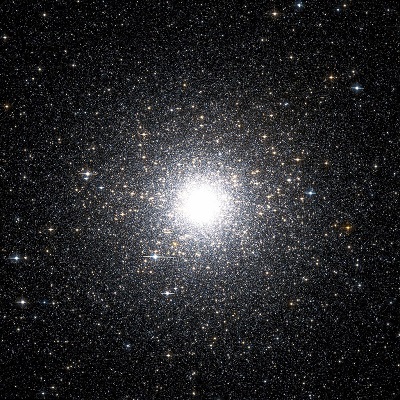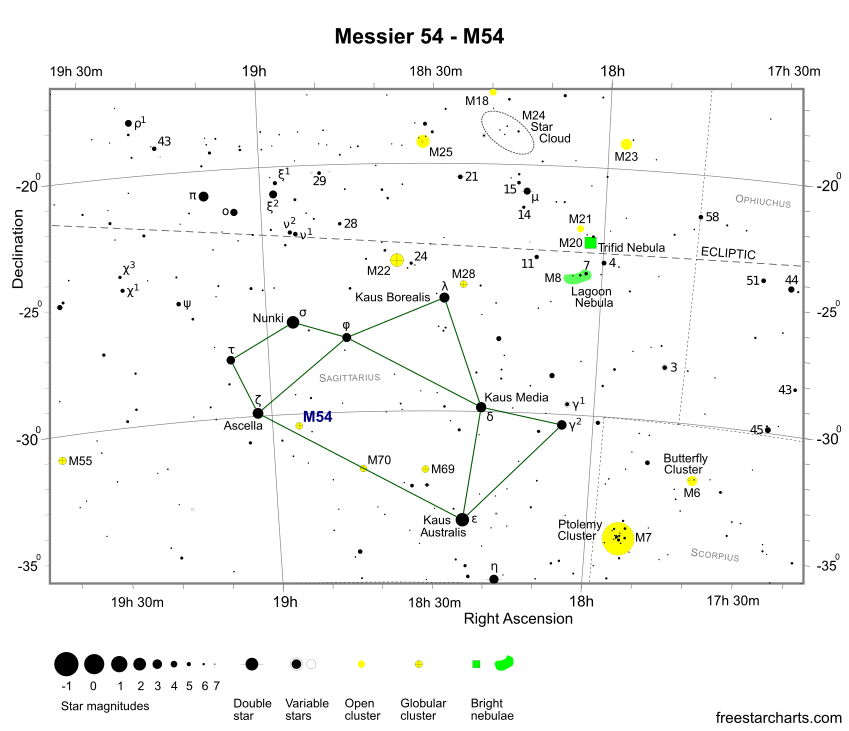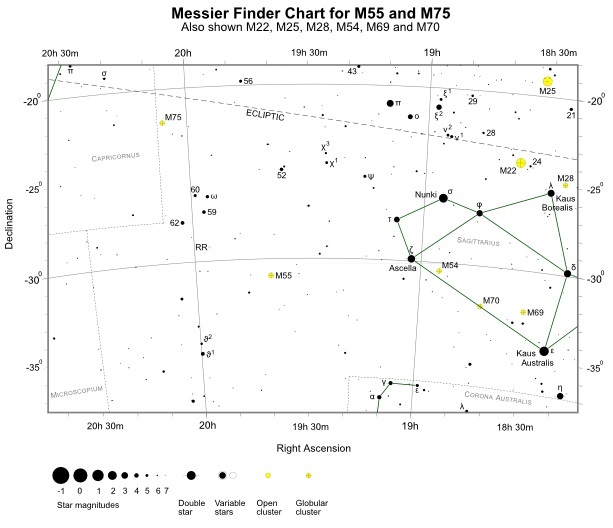M54 is a globular cluster in Sagittarius that’s a staggering 87,400 light-years from Earth. It was discovered by Charles Messier on July 24, 1778 and was for many years thought to be part of the Milky Way but is now believed to belong to the nearby Sagittarius Dwarf Elliptical Galaxy. It owns the distinction of being the first extragalactic globular cluster ever discovered, even though it wasn't recognised as such for over 200 years. Despite its vast distance, M54 is visible in binoculars albeit faintly at mag. +7.9. The fact that it can be seen in binoculars at all is incredible, which is a testament to its large intrinsic size and high absolute brightness. With a diameter of over 300 light-years, it's one of the largest globular's known.
Finding M54 is easy as it lies within the teapot asterism of Sagittarius. The starting point is to focus on the base of the teapot and image a line connecting Ascella (ζ Sgr - mag. +2.6) with Kaus Australis (ε Sgr - mag. +1.8). Positioned about 1.75 degrees along this line and slightly to the north is M54. With a declination of -30 degrees, the cluster is best seen from the Southern Hemisphere during the months of June, July and August. From northern temperate latitudes it’s a more difficult target that never rises high above the horizon.


Finder Chart for M54 - pdf format (credit:- freestarcharts)

Binocular observers may at first overlook this fascinating object. Although the core appears bright, it looks small and starlight on initial observation. Further inspection shows a small degree of nebulosity, somewhat like an out of focus star that hints at its true nature. A small 80mm (3.1-inch) telescope under good seeing reveals a bright point like core surrounded by nebulosity, that tails off gradually from the centre. Larger scopes of the order of 150mm (6-inches) or 200mm (8-inches) aperture show twists and knots across the cluster face. However, due to its considerable distance even the biggest backyard scopes fail to resolve M54.
M54 has a luminosity of 850,000 Sun's and an absolute magnitude of -10. At such a distance its brilliance is not obvious and this is reflected in the apparent magnitude of its brightest stars (+15.5). In reality, the cluster contains over a million stars of which at least 82 are variable and mostly of the RR Lyrae type. There are also two semi-regular red variable stars with periods of 77 and 101 days respectively.
The only other extragalactic globular cluster in the Messier Catalogue is M79 in Lepus, which is a part of the tiny Canis Major Dwarf galaxy.
M54 Data Table
| Messier | 54 |
|---|---|
| NGC | 6715 |
| Object Type | Globular cluster |
| Constellation | Sagittarius |
| Distance (light-years) | 87,400 |
| Apparent Mag. | +7.9 |
| RA (J2000) | 18h 55m 03s |
| DEC (J2000) | -30d 28m 42s |
| Apparent Size (arc mins) | 12 x 12 |
| Radius (light-years) | 153 |
| Age (years) | 13 Billion |
| Number of Stars | >1 Million |
| Notable Feature | Likely belongs to the Sagittarius Dwarf Elliptical Galaxy |